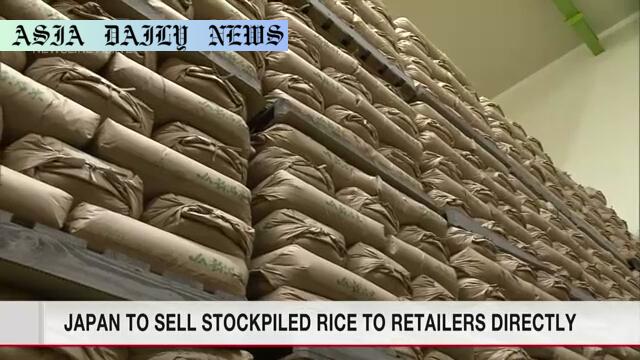Rice: Japan’s agriculture ministry will sell 300,000 tons of stockpiled rice directly to retailers to cut costs for consumers.

Introduction: Addressing the Soaring Prices of Rice in Japan
Rice, a cornerstone of Japanese cuisine, has experienced significant price increases in recent months. A crisis that directly impacts consumers’ grocery bills prompted the Japanese agriculture ministry to take bold and proactive steps. As a solution to soaring prices, the ministry has devised a strategy to sell stockpiled rice directly to retailers, ensuring better affordability for consumers. This unprecedented move highlights the importance of staples like rice in everyday Japanese households.
Japan’s Plan to Release 300,000 Tons of Stockpiled Rice
Japan’s government plans to release 300,000 tons of rice from its 2021 and 2022 stockpiles to selected retailers and e-commerce platforms through no-bid contracts. This volume of rice, previously untouched, will be sold at half the average auction price. This strategic action addresses earlier unsuccessful attempts to manage rice prices through auctions. The process will involve major retailers capable of handling bulk rice, ensuring efficiency in distribution while broadening consumer access to more affordable food staples.
Impact of Lower Prices on Japanese Consumers
One of the most striking outcomes of Japan’s revised strategy is the reduction in pricing. Retailers buying rice at 963 yen (approximately 6.7 USD) for 5 kilograms can offer it at a pre-tax retail price of around 2,000 yen (14 USD) after adding distribution costs. To provide context, supermarkets previously sold the same quantity at over 4,000 yen, which placed a huge financial burden on households.
Challenges and the Ministry’s Commitment
Despite the potential benefits, there are logistical hurdles tied to this endeavor. The delivery of rice to retailers in quantities large enough to meet demand is labor-intensive and requires significant coordination. The Japanese agriculture ministry has demonstrated its dedication to solving these issues by forming a 500-member taskforce consisting of regional bureau personnel. Minister Koizumi Shinjiro emphasized the government’s urgency in stabilizing staple food prices, ensuring that consumers continue to include rice in their daily diets without hesitation or financial strain.
Collaborative Efforts with Technology and Retail Innovations
To modernize rice distribution, the inclusion of e-commerce platforms alongside traditional retailers is an important step. By employing digital platforms, more households and neighborhoods will gain access to the discounted rice quickly and conveniently. This approach also supports modern consumer behaviors while assisting smaller regions to stabilize food access. This symbiosis of technology and retail ensures Japan stays prepared for consumer demands while driving economic growth across sectors.
Conclusion: An Inspiration for Global Food Policy
Japan’s decision to release stockpiled rice to stabilize prices reflects a commitment towards prioritizing consumers in challenging economic times. If successful, this approach could serve as a roadmap for other nations facing similar staple price surges. By addressing both economic challenges and food security, the Japanese government underscores its dedication to its citizens. The effects of this policy change will undoubtedly reshape how staples are regulated and distributed, with consumers as the prime beneficiaries.
Commentary
Proactive Measures to Navigate Economic Challenges
Japan’s recent decision to sell stockpiled rice directly to retailers is an admirable example of proactive governance in the face of economic challenges. By intervening in the market, the government is not only addressing consumer grievances over high prices but also ensuring that the staple food remains accessible to all households. This bold measure underscores the significance of rice within Japanese culture as not merely food but a cultural and economic staple. Other nations could certainly learn from Japan’s decisive approach amid crises.
Empowering Consumers Through Price Reforms
The reduction in rice prices is bound to bring considerable relief to Japanese consumers. Amidst global inflation concerns, offering food staples like rice at lower prices builds trust among citizens and eases financial burdens. Japan’s strategy to offer rice at nearly 50% less than auction prices serves as a strong message of prioritizing public welfare over government profits. This step reinforces the government’s commitment towards meeting its people’s needs effectively and could reshape consumer expectations in the coming months.
The Role of Innovation and Collaboration in Food Distribution
What’s particularly noteworthy is the inclusion of e-commerce platforms in the distribution process. This innovative approach seems timely as digital platforms are increasingly becoming the preferred purchasing method for many consumers. By combining retail innovations with physical distribution, Japan is not just focusing on affordability but also on convenience and accessibility. This coherence between traditional and modern retail solutions ensures long-term viability and adaptability of the rice supply chain.
A Bright Example for Policymakers Worldwide
In conclusion, Japan’s bold decision to release stockpiled rice for direct retail sale speaks to its commitment to economic stability and public welfare. The effectiveness of this measure will not only support domestic households but may also set a precedence for other governments addressing food insecurities or inflation. Food policy experts and citizens alike will be watching closely, drawn by the belief that effective governance lies in actions that directly uplift citizens.


